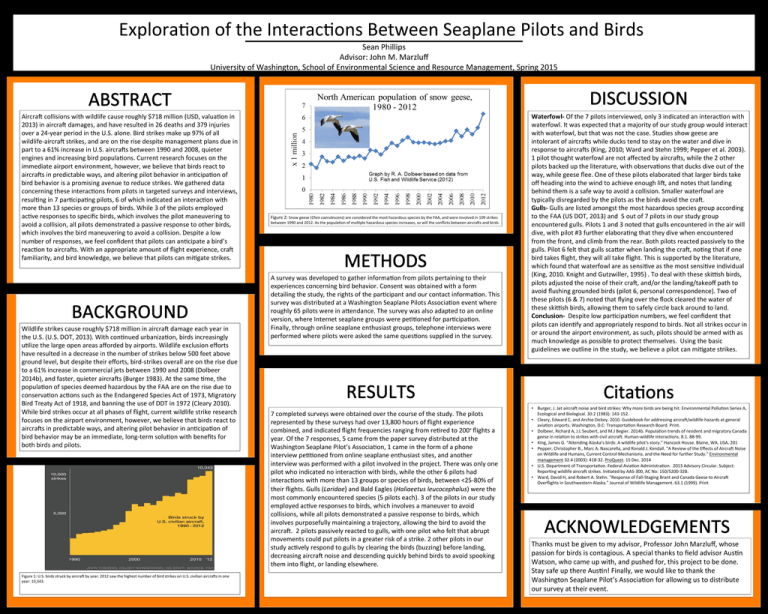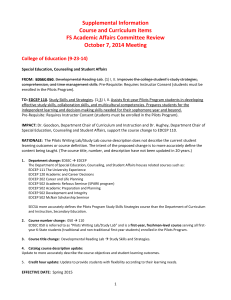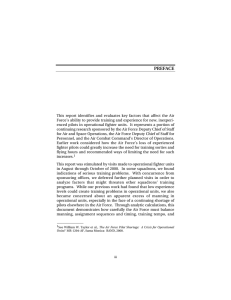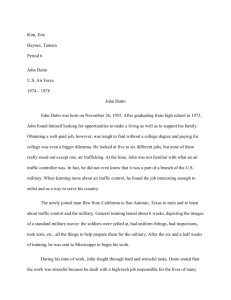Document 13447251
advertisement

ExploraIon of the InteracIons Between Seaplane Pilots and Birds. Sean Phillips Advisor: John M. Marzluff University of Washington, School of Environmental Science and Resource Management, Spring 2015 Aircra5 collisions with wildlife cause roughly $718 million (USD, valuaIon in 2013) in aircra5 damages, and have resulted in 26 deaths and 379 injuries over a 24-­‐year period in the U.S. alone. Bird strikes make up 97% of all wildlife-­‐aircra5 strikes, and are on the rise despite management plans due in part to a 61% increase in U.S. aircra5s between 1990 and 2008, quieter engines and increasing bird populaIons. Current research focuses on the immediate airport environment, however, we believe that birds react to aircra5s in predictable ways, and altering pilot behavior in anIcipaIon of bird behavior is a promising avenue to reduce strikes. We gathered data concerning these interacIons from pilots in targeted surveys and interviews, resulIng in 7 parIcipaIng pilots, 6 of which indicated an interacIon with more than 13 species or groups of birds. While 3 of the pilots employed acIve responses to specific birds, which involves the pilot maneuvering to avoid a collision, all pilots demonstrated a passive response to other birds, which involves the bird maneuvering to avoid a collision. Despite a low number of responses, we feel confident that pilots can anIcipate a bird’s reacIon to aircra5s. With an appropriate amount of flight experience, cra5 familiarity, and bird knowledge, we believe that pilots can miIgate strikes. Wildlife strikes cause roughly $718 million in aircra5 damage each year in the U.S. (U.S. DOT, 2013). With conInued urbanizaIon, birds increasingly uIlize the large open areas afforded by airports. Wildlife exclusion efforts have resulted in a decrease in the number of strikes below 500 feet above ground level, but despite their efforts, bird-­‐strikes overall are on the rise due to a 61% increase in commercial jets between 1990 and 2008 (Dolbeer 2014b), and faster, quieter aircra5s (Burger 1983). At the same Ime, the populaIon of species deemed hazardous by the FAA are on the rise due to conservaIon acIons such as the Endangered Species Act of 1973, Migratory Bird Treaty Act of 1918, and banning the use of DDT in 1972 (Cleary 2010). While bird strikes occur at all phases of flight, current wildlife strike research focuses on the airport environment, however, we believe that birds react to aircra5s in predictable ways, and altering pilot behavior in anIcipaIon of bird behavior may be an immediate, long-­‐term soluIon with benefits for both birds and pilots. Figure 1: U.S. birds struck by aircra5 by year. 2012 saw the highest number of bird strikes on U.S. civilian aircra5s in one year: 10,343. Figure 2: Snow geese (Chen caerulescens) are considered the most hazardous species by the FAA, and were involved in 109 strikes between 1990 and 2012. As the populaIon of mulIple hazardous species increases, so will the conflicts between aircra5s and birds. A survey was developed to gather informaIon from pilots pertaining to their experiences concerning bird behavior. Consent was obtained with a form detailing the study, the rights of the parIcipant and our contact informaIon. This survey was distributed at a Washington Seaplane Pilots AssociaIon event where roughly 65 pilots were in amendance. The survey was also adapted to an online version, where Internet seaplane groups were peIIoned for parIcipaIon. Finally, through online seaplane enthusiast groups, telephone interviews were performed where pilots were asked the same quesIons supplied in the survey. 7 completed surveys were obtained over the course of the study. The pilots represented by these surveys had over 13,800 hours of flight experience combined, and indicated flight frequencies ranging from reIred to 200+ flights a year. Of the 7 responses, 5 came from the paper survey distributed at the Washington Seaplane Pilot’s AssociaIon, 1 came in the form of a phone interview peIIoned from online seaplane enthusiast sites, and another interview was performed with a pilot involved in the project. There was only one pilot who indicated no interacIon with birds, while the other 6 pilots had interacIons with more than 13 groups or species of birds, between <25-­‐80% of their flights. Gulls (Laridae) and Bald Eagles (Haliaeetus leucocephalus) were the most commonly encountered species (5 pilots each). 3 of the pilots in our study employed acIve responses to birds, which involves a maneuver to avoid collisions, while all pilots demonstrated a passive response to birds, which involves purposefully maintaining a trajectory, allowing the bird to avoid the aircra5. 2 pilots passively reacted to gulls, with one pilot who felt that abrupt movements could put pilots in a greater risk of a strike. 2 other pilots in our study acIvely respond to gulls by clearing the birds (buzzing) before landing, decreasing aircra5 noise and descending quickly behind birds to avoid spooking them into flight, or landing elsewhere. Waterfowl-­‐ Of the 7 pilots interviewed, only 3 indicated an interacIon with waterfowl. It was expected that a majority of our study group would interact with waterfowl, but that was not the case. Studies show geese are intolerant of aircra5s while ducks tend to stay on the water and dive in response to aircra5s (King, 2010; Ward and Stehn 1999; Pepper et al. 2003). 1 pilot thought waterfowl are not affected by aircra5s, while the 2 other pilots backed up the literature, with observaIons that ducks dive out of the way, while geese flee. One of these pilots elaborated that larger birds take off heading into the wind to achieve enough li5, and notes that landing behind them is a safe way to avoid a collision. Smaller waterfowl are typically disregarded by the pilots as the birds avoid the cra5. Gulls-­‐ Gulls are listed amongst the most hazardous species group according to the FAA (US DOT, 2013) and 5 out of 7 pilots in our study group encountered gulls. Pilots 1 and 3 noted that gulls encountered in the air will dive, with pilot #3 further elaboraIng that they dive when encountered from the front, and climb from the rear. Both pilots reacted passively to the gulls. Pilot 6 felt that gulls scamer when landing the cra5, noIng that if one bird takes flight, they will all take flight. This is supported by the literature, which found that waterfowl are as sensiIve as the most sensiIve individual (King, 2010. Knight and Gutzwiller, 1995) . To deal with these skitsh birds, pilots adjusted the noise of their cra5, and/or the landing/takeoff path to avoid flushing grounded birds (pilot 6, personal correspondence). Two of these pilots (6 & 7) noted that flying over the flock cleared the water of these skitsh birds, allowing them to safely circle back around to land. Conclusion-­‐ Despite low parIcipaIon numbers, we feel confident that pilots can idenIfy and appropriately respond to birds. Not all strikes occur in or around the airport environment, as such, pilots should be armed with as much knowledge as possible to protect themselves. Using the basic guidelines we outline in the study, we believe a pilot can miIgate strikes. • Burger, J. Jet aircra5 noise and bird strikes: Why more birds are being hit. Environmental PolluIon Series A, Ecological and Biological. 30.2 (1983): 143-­‐152. • Cleary, Edward C, and Archie Dickey. 2010. Guidebook for addressing aircra5/wildlife hazards at general aviaIon airports. Washington, D.C: TransportaIon Research Board. Print. • Dolbeer, Richard A, J.L Seubert, and M.J Begier. 2014b. PopulaIon trends of resident and migratory Canada geese in relaIon to strikes with civil aircra5. Human-­‐wildlife InteracIons. 8.1. 88-­‐99. • King, James G. “Amending Alaska’s birds: A wildlife pilot’s story.” Hancock House. Blaine, WA. USA. 201 • Pepper, Christopher B., Marc A. Nascarella, and Ronald J. Kendall. "A Review of the Effects of Aircra5 Noise on Wildlife and Humans, Current Control Mechanisms, and the Need for further Study." Environmental management 32.4 (2003): 418-­‐32. ProQuest. 15 Dec. 2014 • U.S. Department of TransportaIon. Federal AviaIon AdministraIon. 2013 Advisory Circular. Subject: ReporIng wildlife aircra5 strikes. IniIated by AAS-­‐300, AC No: 150/5200-­‐32B. • Ward, David H, and Robert A. Stehn. "Response of Fall-­‐Staging Brant and Canada Geese to Aircra5 Overflights in Southwestern Alaska." Journal of Wildlife Management. 63.1 (1999). Print Thanks must be given to my advisor, Professor John Marzluff, whose passion for birds is contagious. A special thanks to field advisor AusIn Watson, who came up with, and pushed for, this project to be done. Stay safe up there AusIn! Finally, we would like to thank the Washington Seaplane Pilot’s AssociaIon for allowing us to distribute our survey at their event.



